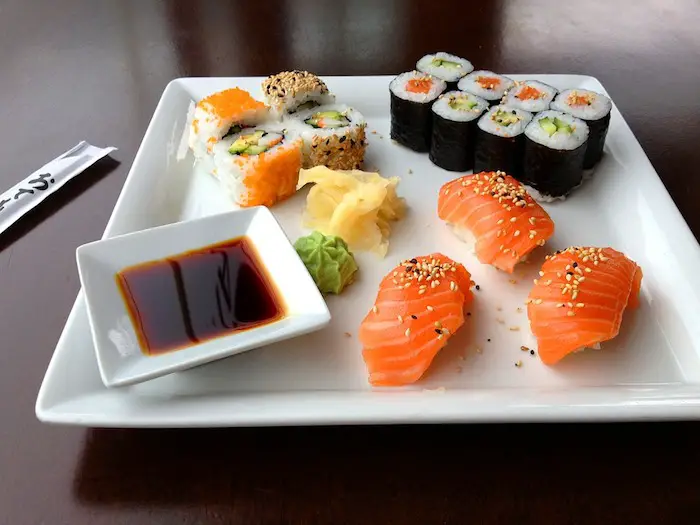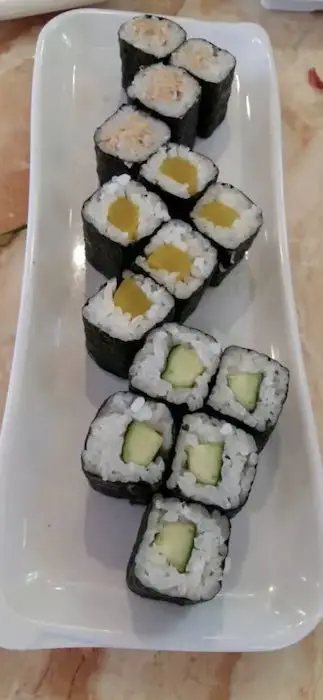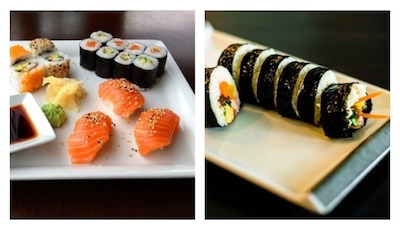We are reader supported. When you purchase through links on our site, we may earn an affiliate commission. Also, as an Amazon affiliate, we earn from qualifying purchases.

I look and taste a lot like sushi but I have a different name. Who am I? I am Kimbap or Gimbap, the Korean version of your favorite Japanese sushi. I guess if Kimbaps could talk, they would say something like this. J
Are Korean kimbap and Japanese sushi the same thing? The answer is yes and no. While they look similar in appearance, they have unique personalities due to the different ingredients used. If you are a beginner, they may look similar to you but ask experts and they will quickly tell the difference.
Contents
What’s The Main Difference Between Kimbap And Sushi?

Let’s start with Japanese sushi that consists of seasoned sushi rice, raw seafood, nori sheet, and vegetables. They are of different types such as makizushi or rolled sushi, nigirizushi (hand-pressed sushi), chirashizushi (scattered sushi in a bowl), inari sushi (pouch sushi), and oshizushi (box sushi).

Korean kimbap is specifically a variation of Japanese makizushi. It consists of cooked and seasoned sushi rice, seasoned vegetables (kimchi, carrots, pickled radish, etc), smoked/ cooked meat (crab, beef, ham, etc), dried seaweed, and fried eggs.
Often known as gimbap, ‘Gim’ refers to the seaweed sheet while ‘bap’ refers to cooked rice. While a kimbap may appear similar to makizushi, the main difference lies in the way sushi rice is seasoned and the fillings are used.
The Rice
In Japanese sushi, rice is seasoned with vinegar, sugar, and salt in the right proportions to enhance the taste and prevent it from turning sour. For Kimbap, rice is seasoned with sesame oil, sesame seeds, and sweetener. The Koreans often use brown rice, quinoa, and other varieties of rice instead of short grain sushi rice.
While some people may use brown rice for making Japanese sushi, but it’s considered as untraditional. You will not find variations of rice at traditional Japanese restaurants. To make perfect sushi, you must use short-grain Japanese rice. See the recipe to cook seasoned sushi rice here.
The Fillings
Another big difference lies in the way fillings are used in sushi and kimbap. Sushi is typically associated with raw fish that must be consumed fresh. If not consumed immediately, it must be stored at the optimum temperature inside a refrigerator to ensure that it stays good for consumption. If sushi rolls containing raw fish are kept outside for more than 12 hours, they must be discarded.
Kimbap, on the other hand, contains cooked meat such as eggs, beef, fishcakes, and imitation crabmeat. The modern chefs also like to use other variations such as ham, kimchi, mayonnaise, and KBBQ. None of the fillings used in kimbap are raw, as a result, the rolls can last for long. You may take them on a road trip and enjoy the next day without the need for refrigeration.
The method of preparation
Kimbap is a common Korean food prepared by mothers and wives at home. Unlike sushi, it is not considered as art and you can see them rolled casually in restaurants. Sushi, on the other hand, is treated as a form of art that is acquired after several years of intensive training. The sushi masters are highly revered and they pass on their skill to those who are below them in rank.
The seaweed is used as is while making sushi but for kimbap, it is toasted and then brushed with some sesame oil. It may also be sprinkled with some salt to enhance the flavor.
The sides
The Korean Kimbap is usually accompanied by yellow pickled radish or some other variety of pickled vegetable. Sushi, on the other hand, is accompanied with pickled ginger, wasabi, soy sauce, and green mustard.
Pickled ginger is used in sushi to cleanse the palate after eating one type of fish and prepare to enjoy the taste of next variety. As kimbap does not include raw fish, there’s no need to cleanse the palate. Similarly, sushi is dipped in soy sauce to enhance the flavor but kimbap is not dipped in anything.
The accompanying dish of kimbap is a yellow pickled radish or some other pickled vegetable. The accompaniments of sushi are pickled ginger and soy sauce mixed with wasabi, and green mustard, which you dip it into. You don’t dip kimbap into anything.
Difference In The Origin Of Sushi And Kimbap
As per the historical records, sushi originated in South East Asia when fish was fermented with rice and salt. The rice was discarded when it was time to consume the fish. With the discovery of vinegar, preserving fish became easier and people started consuming rice along with raw fish. It is believed that sushi came to Japan from China and then it spread to other parts of the world.
There are two debatable versions for the origin of kimbap. Some sources indicate that it was inspired by norimaki, the Japanese sushi roll that comprises of seasoned sushi rice and fillings rolled in seaweed. Other sources say that kimbap was derived from the local tradition of rolling rice and side dishes in seaweed.
How Are Sushi And Kimbap Consumed?
While there’s nothing wrong in eating sushi with your hands (in fact temaki sushi is supposed to be eaten with hands), high-end restaurants will give you chopsticks. Most traditionalists and experienced sushi eaters believe that eating with chopsticks has its own unique charm. For more sushi eating etiquette, you can have a look at my previous article.
For Kimbap, there’s no particular method in which it should be consumed. In Korea, gimbap is considered as a common lunch food for school going students and office workers. If you visit an upscale Korean restaurant, you will be given chopsticks with kimbap. However, the Koreans mostly use their hands to enjoy the delicacy.
Why Is There A Lack Of Variety In Korean Kimbap

If you compare the different variations of sushi and kimbap, you will realize that the former has more options than the latter. In sushi, we have the nigiri style, maki rolls, battleship or
The ingredients used in sushi also vary widely from raw fish of different species, raw seafood, raw meat, eggs, vegetables, and fruits. The fish and meat may be smoked or cooked with seasonings to enhance the flavor.
Korean kimbap lacks exposure in different parts of the world due to the unavailability of certain ingredients used in Korean cuisine. For example, a common filling used in kimbap is myulchi. It is a dish made from dried anchovies, stir-fried in honey barbecue sauce, but it is hard to find fresh myulchi in Asian grocery stores near you.
As a result, Korean dishes are less flexible and adaptable in the international scene. The way Japanese and Chinese food have found their way into US culture, the same cannot be said about Korean cuisine.
The traditionalists may raise a finger at Japanese restaurants in the US for being unauthentic and guilty of using ingredients unfamiliar to the native people. However, these sushi variations are extremely popular in the western countries, and there are many sushi rolls named after US states and cities (for more info).
Why Is Japanese Sushi More Popular Than Korean Kimbap
Unlike Korean kimbap, which is less adaptable, or flexible, Japanese sushi can be prepared in numerous ways using ingredients that are easily found in Asian grocery stores. Most Korean recipes are incomplete until you use the toasted sesame oil or red pepper paste. There are no good substitutes for these.
Both red pepper and sesame oil are used for preparing Myulchi. Furthermore, the Koreans coat their kimbap roll in a film of toasted sesame oil to give it a unique nutty flavor. This completes the presentation and aroma that Kimbap is known for. Sushi does not use any oil for making rolls.
What Are The Different Variations Of Korean Kimbap?
You probably already know the different variations of Japanese sushi. In case you are a beginner, read this article to understand the difference between nigirizushi, sashimi, sushi roll (maki), hand roll (temaki), and gunkan sushi.
Korean Kimbap is mainly of three different varieties: Chungmu Kimbap, Mayak Kimbap, and Samgak Kimbap. Let’s look into the details of each.
Chungmu Kimbap is the thin roll with only rice as the sole filling. It may often be accompanied by radish kimchi or squid salad for additional flavor.
Mayak Kimbap is the small-sized variation and it is usually filled with finely sliced carrots, pickled radish, and spinach. The rice is sprinkled with sesame seeds and served with pungent mustard and soy sauce.
Samgak Kimbap is the triangular-shaped variation of sushi and it is often compared with Japanese Onigiri. It is a quick and filling snack used as a staple in Korean households.
| Sushi | Kimbap | |
| Origin | Japan | Korea |
| Rice | Short-grain rice | Short-grain rice |
| Seasoning | Seasoned with vinegar, sugar, and salt | Seasoned with sesame oil and |
| Fillings | Raw fish, cooked meat, vegetables, fruits | Ham, egg strips, bulgogi, spinach, carrot, burdock root, cucumber and canned tuna |
| Who makes them in restaurants | Mostly male sushi chefs | Korean women |
| Tradition | Traditional cuisine | Casual food |
| Seaweed | Raw or toasted | Toasted and brushed with sesame oil |
| Side dish | Pickled ginger (gari), wasabi | Yellow pickled raddish, pickled vegetables |
| Sauce | soy sauce | no dipping |
| Varieties | 5 main varieties of sushi | 3 main varieties of kimbap |
How To Make Korean Kimbap (Gimbap)
To prepare gimbap or kimbap, the seaweed sheets is toasted over low heat and then brushed with sesame oil. It is sprinkled with salt to enhance flavor. You will need a Gimbal made of bamboo in order to make a roll.
The toasted seaweed is placed on the gimbal and a thin layer of rice is spread evenly on the area that is not brushed with oil. The fillings are then added on top of the rice layer and the gimbal is rolled gently to form a compact cylindrical shape. The roll is then cut into smaller pieces before servings. Let’s check out an easy Kimbap recipe.
What you will need:
- 3 cups of cooked short-grain white rice
- 1 tsp toasted sesame seeds
- Roasted sheets of seaweed (also called gim, nori, or laver)
- Yellow pickled radish cut into pencil-size strips (also known as danmuji or takuan)
- 1 carrot, julienne cut and sautéed in sesame oil until they turn crisp and tender
- 2-egg omelet made using sesame oil and salt, and cut into thin strips
- 4 cups of spinach leaves, blanched, drained, and seasoned with sesame seeds and salt
Instructions
Prepare all the ingredients such as sushi rice, fillings, nori sheets etc. Keep a bowl of water to moisten your hands to prevent sushi rice from sticking to it.
Place the gimbal made of bamboo on a working surface and put the seaweed sheet on it, rough side facing upwards.
Now take a medium ball of rice and spread it evenly on the Nori sheet, pressing gently with your moistened fingers. Leave 2/3 of the seaweed empty on the top. Brush some sesame oil on the rice layer and also sprinkle some sesame seeds on it.
Arrange the fillings neatly in a horizontal pattern over the nori sheet, starting rolling from the bottom. Press gently as you roll to form a compact cylindrical shape.
Dip your fingers in the water bowl and seal the end of the roll by moistening the seaweed. Give the roll one tight hug with the help of the bamboo mat and brush some sesame oil over the roll to prevent it from drying out.
Take a sharp Japanese knife like this and coat the blade with a layer of sesame oil. Now cut the roll into small bite-size pieces. When making several rolls, make sure you wipe the blade periodically with the oil for smooth cuts. Sprinkle toasted sesame seeds on the top for garnish.
Related Questions
How long can Kimbap last?
Preparing the ingredients for kimbap is time-consuming but once you have them ready, they can be stored for 1-2 weeks in the refrigerator. You just need to make hot rice and use the filling to make kimbap quickly. Once, rolled, they must be consumed in 24 hours as the rice will harden and seaweed will turn soggy if kept for too long.
What’s the best way to store kimbap in the refrigerator?
The sliced kimbap should be kept in an airtight container and they can be stored in the refrigerator for several hours without losing the texture and flavor. If you plan to eat the next day, do not slice the roll and keep it well packaged inside the refrigerator.
Do you eat kimbap with soy sauce?
Traditionally, Kimbap is not served with soy sauce or any other dip. However, some people may prefer to enjoy it with sauce. In the restaurants, they usually serve Kimbap with pickled radish or some other type of pickled vegetable.
Which came first – kimbap or sushi?
Sushi of course, as the origin of Narezushi, can be traced back to the 2nd century CE. Kimbap is widely believed to have been inspired by Japanese sushi, hence it is often referred to as the Korean version of sushi.


Comments
Pingback: What Is Oba In Sushi? - Easy Homemade Sushi